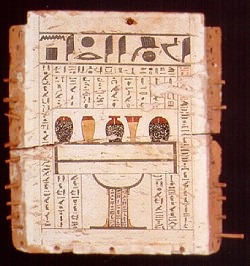
Term used to indicate the funerary texts written on the sides of rectangular coffins in hieratic or cursive hieroglyphs in the 1st Intermediate Period and the Middle Kingdom, as well as on tomb walls, papyrus and other objects in the tomb equipment. Many of the texts have been derived from the Pyramid Texts inscribed on the walls of Old Kingdom pyramids, the earliest being Unas. At that time, use of the funerary texts was still confined to the king but as a result of the collapse of the centralized state at the end of the Old Kingdom, the spells also became available to an elite section of the population. In later centuries, part of this textual material would become available to an even wider section of the population (Book of the Dead). A total of about 1200 Coffin Text spells are known; each coffin has only a small selection. The division of the spells over the six panels of the coffin is not always coincidental - spells concerning the head of the deceased, for example, are usually found at the head end of the coffin. The Book of Two Ways, a description of the underworld accompanied by a map (compare with the later Amduat), is inscribed on the bottom of the coffin so that the deceased is literally on his way. The spells are a colourful collection of texts; many of them have as a central theme the continued life of the deceased and his resurrection; spells to provide him with food and other necessities, borrowed from offering rituals, alternate with texts to reunite the deceased with his family or with texts to enable him to transform himself at will or to evade all kinds of dangers. Depictions of the underworld and its inhabitants are very common, with a definite emphasis on the so-called Field of Offerings. There are also spells designed to prevent the deceased having to work in the hereafter (compare the idea behind the shabti). Many spells have titles which explain the aim of the text, some also have a postscript, often instructions for use.